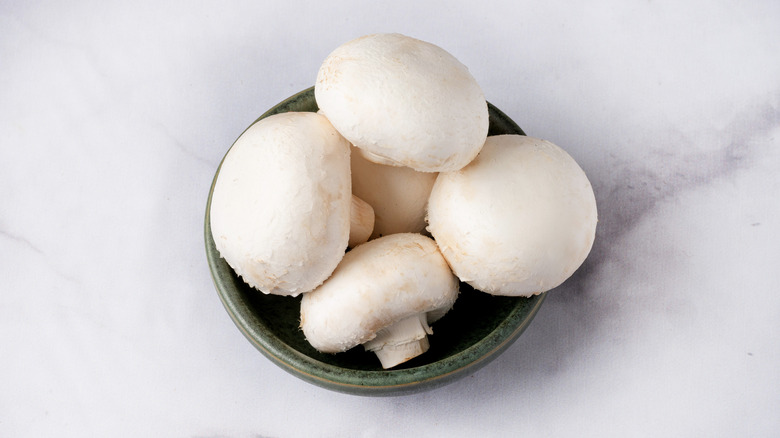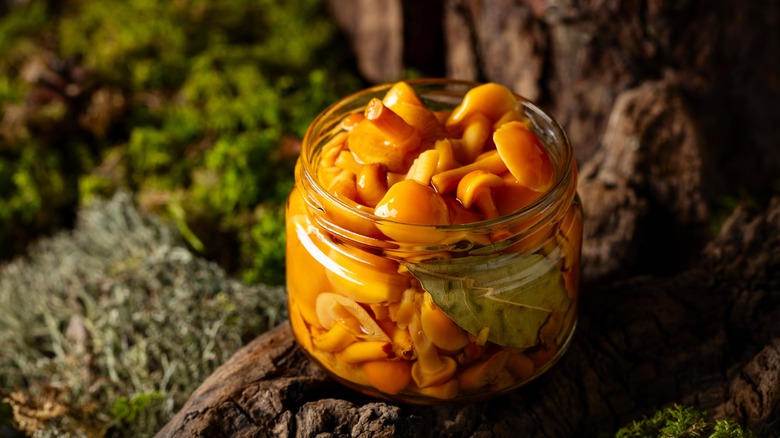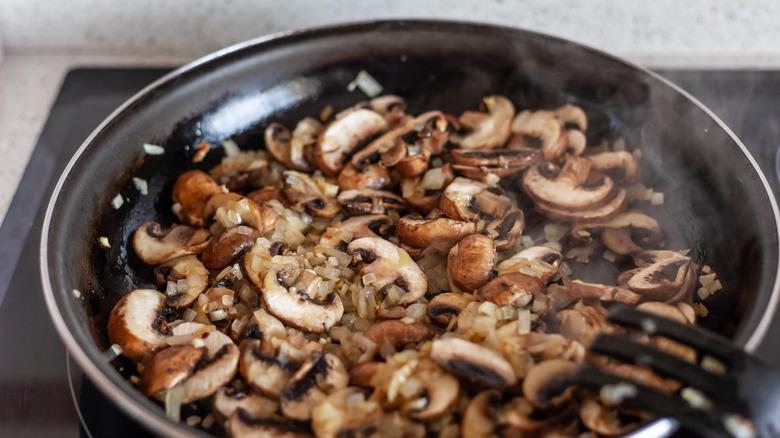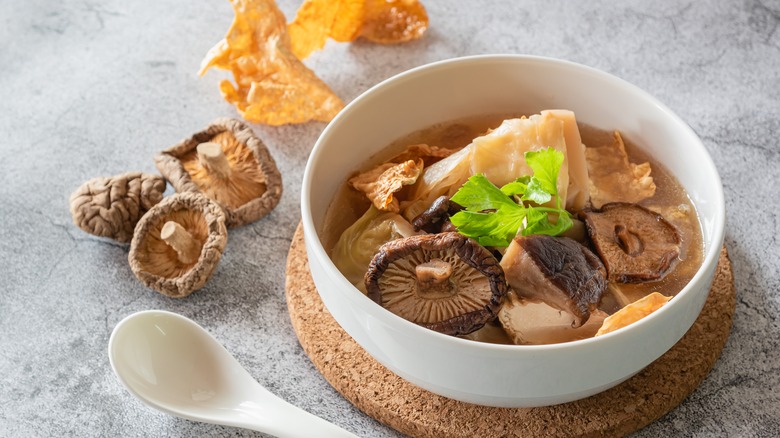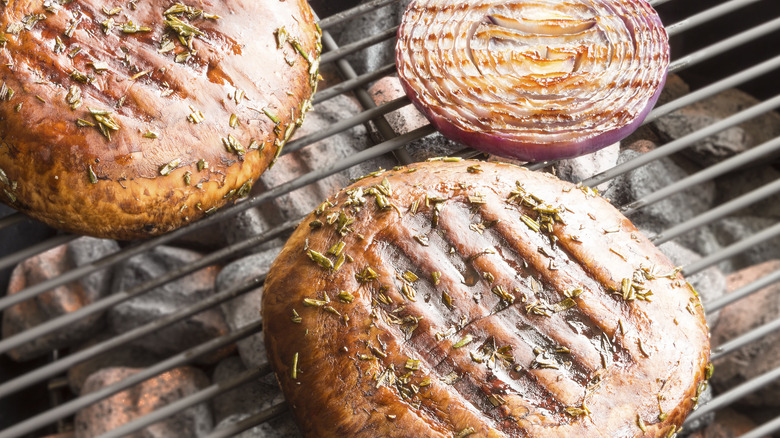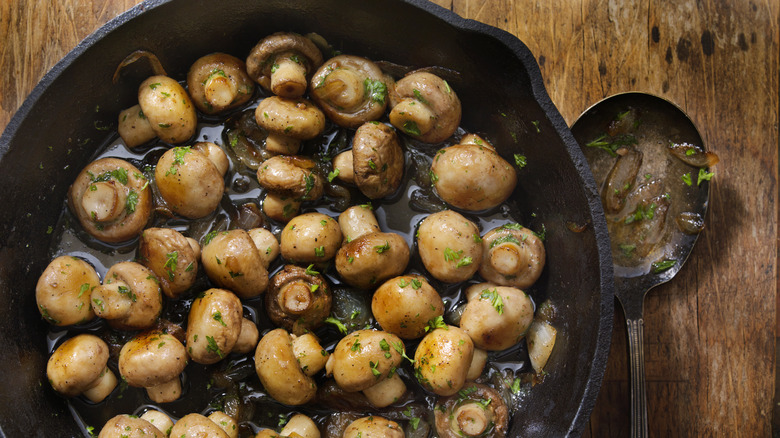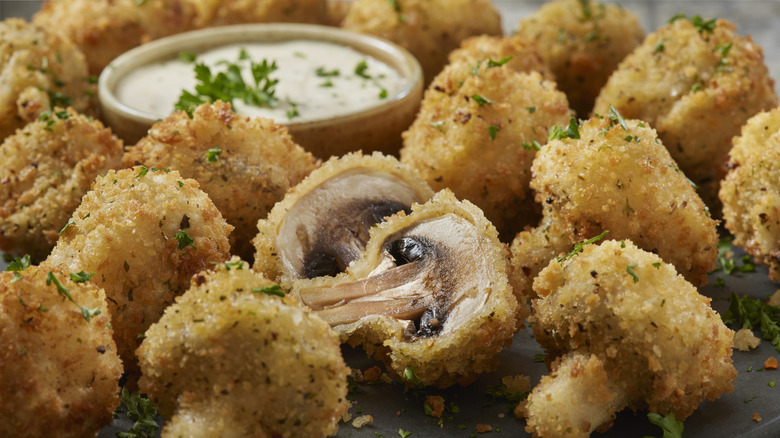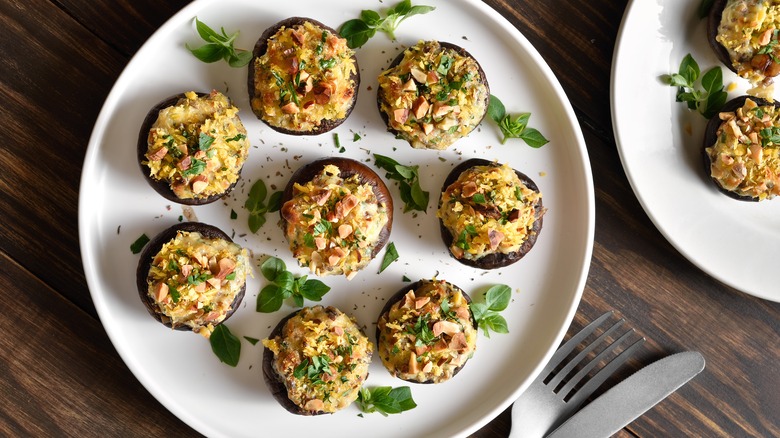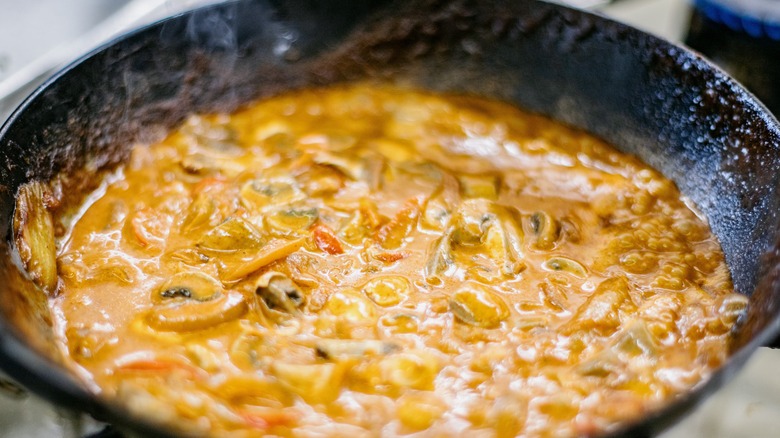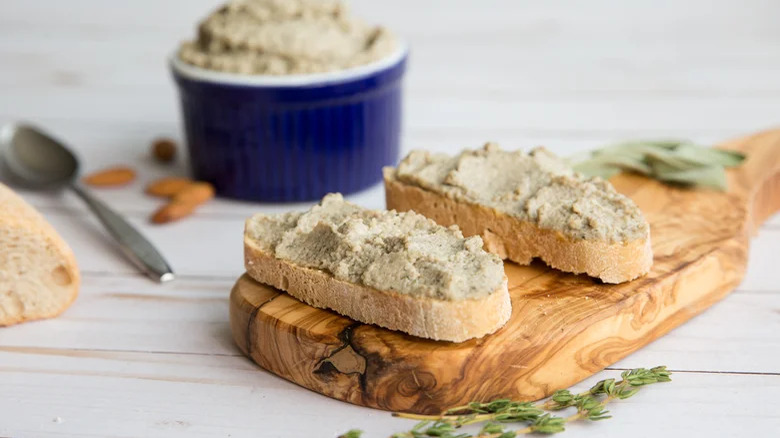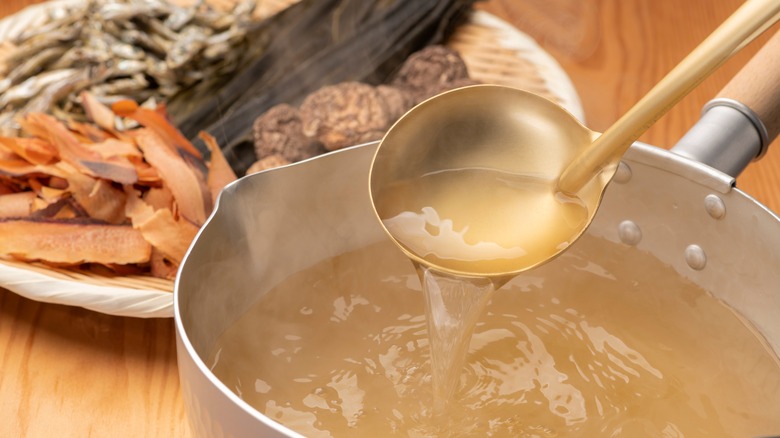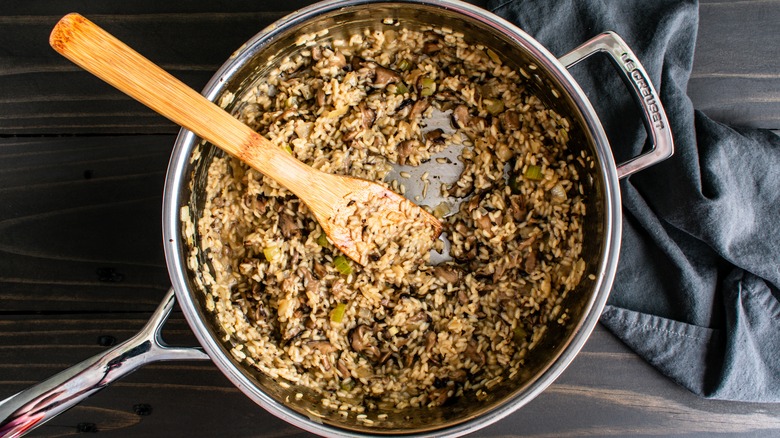11 Ways To Take Plain Mushrooms To The Next Level
Mushrooms are a bit of a divisive ingredient and, if we're being completely honest, that's understandable. When this fungus is poorly prepared, it can be bland in flavor or even downright slimy in texture. But in the hands of an expert, mushrooms can achieve nothing les than pure perfection, which might be why chefs love them so. "Everywhere I go I always put a mushroom dish on the menu of some sort," says chef Derek Boccagno, Executive Chef for Hotel Chelsea.
Pros know that attention to detail matters. When it comes to mushrooms, the best method of preparation will vary depending on the variety you're working with. Massive maitake, according to Boccagno, are best when roasted or grilled whole to take advantage of what he describes as their "dynamic shape." And simple cooking methods work well for these mushrooms due not just to their aesthetic but their flavor, says to Sung Park, owner and chef at Kothai Republic in San Francisco. "The more 'impressive' mushrooms tend to have very distinct flavors and aromas and just need a simple nudge to help them along," he says.
Even run of the mill button mushrooms can be exquisite given the right treatment. Chef Madalyn Durrant of Chicago's Bar Parisette says her favorites are simple chestnut mushrooms, which she loves for their chewy texture and nutty flavor. Whether you're a confirmed mushroom lover or a skeptic ready to change your mind, our experts are here to help you take plain mushrooms to next-level deliciousness.
1. Marinate mushrooms
Mushrooms are famous for being culinary sponges, which is why it's important during preparation to wash them without allowing them to soak, lest those mushrooms become watery and bland. But this sponge-like nature also makes mushrooms perfectly primed to take up a flavorful marinade. "You can marinate with soy and sugar to enrich the umami," explains Park, "or make escabeche to bring brightness to the deep fungal flavor."
While marinated mushrooms can stand alone in some cases, as with chanterelle. When served with a golden raisin, sherry vinegar, and thyme conserva, Wildweed chef and owner David Jackman (who also enjoyed foraging for wild mushrooms) says that chanterelles may well be his favorite mushroom. But in other cases, marinating is just one step towards achieving mushroom nirvana. Some pro chefs marinate mushrooms before roasting or grilling them to ensure the very best of the ingredient's flavor comes through.
Wild Rye executive chef Karl Holl, another avid forager, loves his mushrooms when they are both "marinated and smoked, which gives umami, meaty flavors [...] At Wild Rye," he explains, "our Grilled 'Brasada Hot' Maitake is brined for 4 hours, then grilled and tossed in our own 'Nashville hot' sauce, served over braised greens and crispy polenta."
That said, we ought to offer a word of warning: A little bit goes a long way when it comes to marinating mushrooms. Just 30 minutes will give you little flavor bombs. Any more than that and you're likely to get soggy, slimy sponges.
2. Go classic and sauté
Sautéeing mushrooms is a classic technique for a reason, according to Sarah Seghi, Executive Chef of Eberly. "The best way I believe to bring out the flavor of mushrooms is by simply sautéing them," she says. "Getting a nice color on the mushrooms will intensify their flavor as well as being delicious." This simple technique is her favorite way to bring out the best in mushrooms like chanterelles and morels, both of which she sautés in butter and finishes with sea salt and freshly cracked black pepper. Park agrees. "At the end of the day," he says, "simplicity might be best; hot pan, a bit of butter slightly browned, and a good pinch of salt."
It's also a great vehicle for added flavors, especially woodsy herbs like thyme, rosemary, and oregano. These, Park says, "bring another layer of aroma and flavor to a dull mushroom." Chanterelles in particular "are best simply sautéed in a pan with butter and thyme."
Humble creminis, meanwhile, are transformed when cooked in beef fat and served as a side to a rich steak, according to Seghi. "Once you've seared your steak in a cast iron pan, throw your cremini mushrooms in," she counsels, noting she then adds garlic and thyme before deglazing the pan with Cabernet vinegar, Worcestershire sauce, and a splash of beef bone broth. "Once the liquid has cooked off, the mushrooms are able to get great caramelization and the flavor is phenomenal."
3. Braise them in a flavorful liquid
Braising is a cooking method that is typically used to suffuse an ingredient with loads of flavor over a long period of time, all while using relatively low heat. While it's a common technique that's deployed to prepare sinuous cuts of beef, pork, or chicken, for Park and many other chefs, it's also the perfect way to make mushrooms shine.
To braise mushrooms, you should begin by sautéing them in a hot pan alongside aromatics like shallot, onion, herbs, or garlic. Cook the mushrooms until they're browned on the outside. At the same time, you can begin to heat the braising liquid of your choice, then add it to the pan of mushrooms when the liquid and fungus are both ready.
If you're looking for braising liquid suggestions, Park suggests braising matsutake mushrooms in soy sauce alongside savoy cabbage to create a savory vegetarian preparation that is sure to convert even the most carnivorous of diners. He also notes that this technique can be carried out with a wide variety of mushrooms from portobello to cremini. You can also braise them in mixtures that are flavored with seemingly anything from red wine to dark ale, to stock. Whatever flavors you use are sure to be soaked up by the mushrooms until they become toothsome pillows of flavor.
4. Grill larger mushroom varieties
High-heat methods like grilling can work wonders in bringing out the umami richness and meaty texture of certain mushroom varieties. "I love Portobellos grilled with a sundried tomato and mint compound butter," says Park. Indeed, this flavorful combo is the ideal vegetarian offering for your next cookout, whether it's served on its own or placed on a bun as a plant-based burger that's made with all the traditional trimmings. We think this ought to include grilled red onions, which will add a touch of allium bite and sweetness to any veggie burger.
Of course, not all mushrooms are as well-suited to throwing straight on the grill as big-cap mushrooms such as Portobellos. After all, smaller mushrooms can easily fall through the grill grate as they cook and quickly become wasted ingredients. It doesn't mean you have to eschew them entirely, however. Consider threading small mushrooms onto wooden skewers before grilling so your hard work doesn't go up in flames. Also, be sure to soak the wooden skewers in advance to keep them from singeing over the high heat, too.
5. Roast mushrooms
Mushrooms contain quite a bit of water — about 80 to 90% of their total weight, depending on the variety. So it should be no surprise that they lend themselves well to roasting, which concentrates their flavor. "I like to pre-roast them to remove some moisture," explains Durrant, who then finishes them off in a pan with butter and sherry vinegar to add flavor. Seghi also likes to reduce the moisture in a mushroom with a trip through the oven, as with a recent dish she served at Eberly, where she roasted a lion's mane mushroom in the oven before pressing it overnight to create a "steak" she breaded in cornmeal and fried.
"By roasting it and pulling out some of the moisture," she says, "the end result gave the Lion's mane an even meatier texture that was perfectly paired with the crisp exterior from the cornmeal."
But roasting mushrooms doesn't need to be a mere means to an end. Boccagno recalls a dish he used to make that involved wood roasting a chunk of maitake mushroom before dressing it with an allium vinaigrette made by combining garlic scapes, garlic chives, shallots, and onions with rice wine vinegar, fish sauce, and mushroom broth. And you can go even simpler, according to Holl. "I do love mushrooms just classically pan-roasted in butter," he says, "and as basic as it may seem, there is something special about simply roasting a mushroom."
6. Fry the fungus
The meatiness of mushrooms can help to make them the perfect contenders for frying, as Seghi shows well with her cornmeal-dredged lion's mane mushroom. After roasting the mushroom and pressing it into a steak-like shape, she brushes it in a flavorful house-made miso mixture before dredging it in seasoned cornmeal. She then shallow-fries it in a cast iron pan, a step that she says helps the mushroom to achieve a nicely crispy crust. "We served this with a yukon gold gratin, a spicy dill remoulade, pickled shallots, and crispy sunchoke chips," she notes.
You can use an even easier technique to transform simple button mushrooms into cheesy, crispy morsels that are sure to please. First, slice the mushrooms into relatively thin pieces, then batter and bread them before putting them into a deep-fry for five to six minutes, or until they become golden brown and delicious. Meanwhile, Parmesan-crusted fried mushrooms are plenty delicious on their own, but you can make it all the better by serving them with a flavorful dip such as a homemade marinara sauce or spicy Sriracha-infused mayonnaise.
7. Stuff mushrooms with extra ingredients
Some mushrooms, such as cremini, mushroom, or Portobello varieties, seem to be tailor-made for stuffing, given that they have an easily detachable central stem. Once that stem is removed, the caps that remain become the perfect vessel to fill with a flavorful stuffing. Said stuffing is often seasoned with alliums, herbs, and cheese for a savory delight.
Breadcrumbs can make a great base for mushroom stuffings, as they help to absorb some of the moisture in the mushroom and transfer these flavorful juices to the filling itself. Such is the case for a cheddar-bacon filling, which dresses up massive Portobello mushrooms. Horseradish and crab, meanwhile, make an exquisite stuffing for button mushrooms and transform them into a special occasion canapé. And since mushrooms are so good at absorbing other flavors, it's perhaps no surprise that in Paris, dining establishments have taken full advantage of mushrooms as the perfect edible delivery vehicle for escargot. They absorb every drop of the garlic- and parsley-infused butter that traditionally accompanies this classic French dish.
8. Simmer them
To bring out a mushroom's essence, many of our experts recommend simply simmering them in a flavorful liquid. "Gently simmering mushrooms is the best way to highlight them," says Park. "That distinct fungal aroma fills the kitchen, any liquid that you use is immediately umami-fied, and they only need the simplest of seasonings. In our house, that's roasted chili-infused soy."
He recalls first encountering this technique at monasteries in Korea, which he visited with his uncle. There, he says that the local monks would simmer matsutake mushrooms that they had foraged in the local mountains, combining them simply with a few vegetables and a touch of soy sauce. "The almost truffle-like taste, with aromas of pine and hints of cinnamon, were incredible," he recalls.
The same technique can be applied to dried mushrooms. "Dried shiitakes are wonderful because even after rehydrating them and using the steeped liquid for other purposes, the mushrooms themselves become plump, umami bombs," he says. "They can then be simmered with soy sauce for a braised shiitake mushroom side or mixed with citrus, herbs, and vinegar for an escabeche."
9. Make mushroom pâté
While the word pâté may make you think of smoothly processed chicken livers, mushrooms actually make the perfect base for a plant-driven mushroom pâté that you can then serve on crostini or toast. You can easily season white button mushrooms with aromatic garlic and onion, as well as a few fresh herbs for an extra boost of flavor. Peeled almonds add a creamy texture and a bit of protein to the dish, which is enriched with both butter and olive oil for even more richness.
If you prefer a more intense pâté, take advantage of other mushroom varieties, like king oyster mushrooms, which have a slightly more robust flavor. This becomes all the more apparent with the addition of porcini powder, which will help to intensify the earthy flavor of the finished pâté. And don't forget that any mushroom scraps, such as stems that were set aside in the making of stuffed mushrooms, are very ready to be upcycled into a creamy pâté that doubles as a means of avoiding food waste.
10. Transform mushrooms into a flavorful sauce or stock
Dried mushrooms especially are particularly lovely when they are incorporated into stocks and broths, which are then an excellent base for all manner of soups and sauces, according to Park. "Dried mushrooms lend themselves so well to making vegan stocks and sauces," he says. "Porcinis simmered with a bit of kombu make for an absolutely rich vegan base to any soup or sauce." Seghi agrees. "I love making very concentrated mushroom stocks which makes infusing the mushroom flavor into a variety of sauces very easy and flavorful!" she notes.
Such stocks can be used as a base for many dishes, including risottos, pastas, soups, and more. Seghi loves using mushroom stock as the foundation for a mushroom bisque that's crafted from roasted button, porcini, and maitake mushrooms. And why note a classic green bean casserole, too? "What we don't use in our green bean casserole, we save for other meals throughout the week," she adds. Jackman even uses dried mushrooms to make a homemade XO sauce, cooking down onions, mushrooms, and seasonings in oil until they become a paste that's then fried and soon takes on a rich umami flavor.
But for Boccagno, there's no need to complicate things. As he has it, these stocks are perhaps best enjoyed on their own, noting that dried mushrooms can be used "solo, as more of a light dashi or tea." This may be the best way to take advantage of their subtle, woodsy flavors.
11. Make mushroom risotto or porridge
Mushroom risotto is a classic dish that our experts absolutely adore. And with just a bit of planning, you can make it too, infusing it with mushroom flavor from beginning to end. To start things off, you'll need to craft a rich, savory broth, something Boccagno typically makes with a combination of button mushrooms and dried shiitake and porcinis. This, he says, makes " a really strong broth that can come through and shine with the other ingredients."
Durrant agrees. "I love shiitake as a base for both soups and risottos," she says. But she pushes her risotto to the next level with a topping made from a combination of chestnut, maitake, and chanterelle mushrooms, which she sautés in butter and fresh herbs. Park uses a similar base for his mushroom porridge, which he says he prefers over risotto and attributes to his Korean background where such dishes are somewhat more common. Dried shiitakes are his "personal go-to," he says, noting that they "just have that extra depth and versatility. I am able to use them for both the liquid and the mushrooms when building a porridge."
Holl, meanwhile, prefers meaty porcini mushrooms for risotto and Seghi loves oyster mushrooms. "You can very easily pull the mushrooms into thin slivers that caramelize to perfection," Seghi says, noting that these "lend themselves perfectly to creamy risotto, finished with spring peas, and garnished with chives and Parmigiano-Reggiano."
